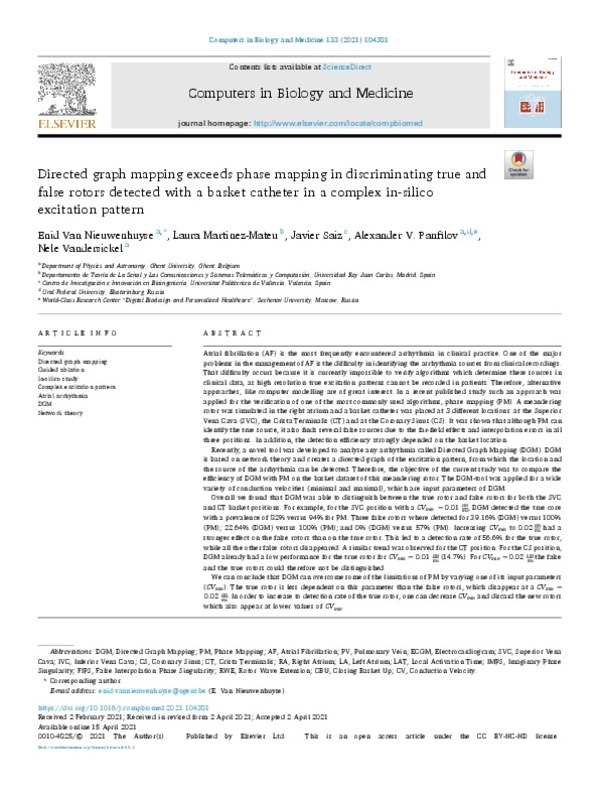|
Resumen:
|
[EN] Atrial fibrillation (AF) is the most frequently encountered arrhythmia in clinical practise. One of the major problems in the management of AF is the difficulty in identifying the arrhythmia sources from clinical ...[+]
[EN] Atrial fibrillation (AF) is the most frequently encountered arrhythmia in clinical practise. One of the major problems in the management of AF is the difficulty in identifying the arrhythmia sources from clinical recordings. That difficulty occurs because it is currently impossible to verify algorithms which determine these sources in clinical data, as high resolution true excitation patterns cannot be recorded in patients. Therefore, alternative approaches, like computer modelling are of great interest. In a recent published study such an approach was applied for the verification of one of the most commonly used algorithms, phase mapping (PM). A meandering rotor was simulated in the right atrium and a basket catheter was placed at 3 different locations: at the Superior Vena Cava (SVC), the Crista Terminalis (CT) and at the Coronary Sinus (CS). It was shown that although PM can identify the true source, it also finds several false sources due to the far-field effects and interpolation errors in all three positions. In addition, the detection efficiency strongly depended on the basket location.
Recently, a novel tool was developed to analyse any arrhythmia called Directed Graph Mapping (DGM). DGM is based on network theory and creates a directed graph of the excitation pattern, from which the location and the source of the arrhythmia can be detected. Therefore, the objective of the current study was to compare the efficiency of DGM with PM on the basket dataset of this meandering rotor. The DGM-tool was applied for a wide variety of conduction velocities (minimal and maximal), which are input parameters of DGM.
Overall we found that DGM was able to distinguish between the true rotor and false rotors for both the SVC and CT basket positions. For example, for the SVC position with a CVmin = 0.01 cmms, DGM detected the true core with a prevalence of 82% versus 94% for PM. Three false rotors where detected for 39.16% (DGM) versus 100% (PM); 22.64% (DGM) versus 100% (PM); and 0% (DGM) versus 57% (PM). Increasing CVmin to 0.02 cmms had a stronger effect on the false rotors than on the true rotor. This led to a detection rate of 56.6% for the true rotor, while all the other false rotors disappeared. A similar trend was observed for the CT position. For the CS position, DGM already had a low performance for the true rotor for CVmin = 0.01 cmms (14.7%). For CVmin= 0.02 cmms the false and the true rotors could therefore not be distinguished.
We can conclude that DGM can overcome some of the limitations of PM by varying one of its input parameters (CVmin). The true rotor is less dependent on this parameter than the false rotors, which disappear at a CVmin = 0.02 cmms. In order to increase to detection rate of the true rotor, one can decrease CVmin and discard the new rotors which also appear at lower values of CVmin.
[-]
|
|
Agradecimientos:
|
Supported in part by Direccion General de Politica Cientifica de la Generalitat Valenciana (grant ID PROMETEU 2020/043) , Valencia, Spain. This project has received funding from the European Research Council (ERC) under ...[+]
Supported in part by Direccion General de Politica Cientifica de la Generalitat Valenciana (grant ID PROMETEU 2020/043) , Valencia, Spain. This project has received funding from the European Research Council (ERC) under the European Union's Horizon 2020 research and innovation programme (grant agreement No 900008) , Brussels, Belgium. Research at Sechenov University was financed by the Ministry of Science and Higher Education of the Russian Federation within the framework of state support for the creation and development of WorldClass Research Centers "Digital biodesign and personalized healthcare" (grant ID 075152020926) , Russia.
[-]
|









